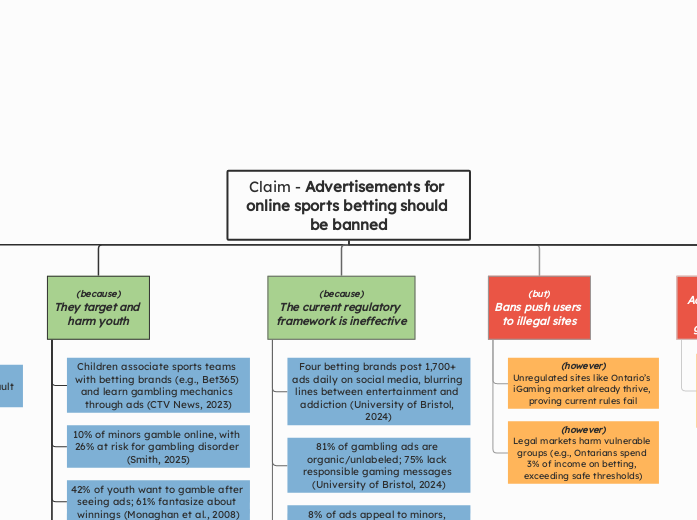Claim - Advertisements for online sports betting should be banned
(because)
They increase risks to public health
Gambling ads correlate with increased gambling behavior (r = 0.24), mirroring alcohol/tobacco ad impacts (Bouguettaya et al., 2020)
Over 300,000 Canadians are at "severe/moderate" risk of harm, with ads triggering problem gamblers (CTV News, 2023)
In-play betting and "skill-enhancing" ads exploit cognitive biases, accelerating addiction (Lopez-Gonzalez et al., 2017)
Problem gamblers harm 6–8 others; 37% commit intimate partner violence (Smith, 2025)
A 10% increase in gambling spending raises mortgage default risk by 97.5% (Smith, 2025)
(because)
They target and harm youth
Children associate sports teams with betting brands (e.g., Bet365) and learn gambling mechanics through ads (CTV News, 2023)
10% of minors gamble online, with 26% at risk for gambling disorder (Smith, 2025)
42% of youth want to gamble after seeing ads; 61% fantasize about winnings (Monaghan et al., 2008)
Ads saturate youth spaces: 96% see TV ads, 93% see internet ads (Monaghan et al., 2008)
Sports broadcasts air 8.5 minutes of gambling ads per game (CTV News, 2023)
Ads exploit cognitive biases (e.g., "representativeness heuristic") to distort decision-making (Lopez-Gonzalez et al., 2017)
(because)
The current regulatory framework is ineffective
Four betting brands post 1,700+ ads daily on social media, blurring lines between entertainment and addiction (University of Bristol, 2024)
81% of gambling ads are organic/unlabeled; 75% lack responsible gaming messages (University of Bristol, 2024)
8% of ads appeal to minors, violating guidelines (University of Bristol, 2024)
(but)
Bans push users to illegal sites
(however)
Unregulated sites like Ontario’s iGaming market already thrive, proving current rules fail
(however)
Legal markets harm vulnerable groups (e.g., Ontarians spend 3% of income on betting, exceeding safe thresholds)
(but)
Ads don’t necessarily cause increased gambling problems
(however)
The precautionary principle justifies action given credible evidence of harm, even without absolute causality (e.g., tobacco ad bans)
(but)
Parental controls can limit youth exposure
(however)
Ads are pervasive: 2.8 gambling references per minute during live sports (Lewis, 2024)
(however)
Youth see 8.5 minutes of ads during Maple Leafs games (Smith, 2024)
(but)
Banning ads harms the gambling industry’s economy
(however)
Social costs (e.g., family strain, mortgage defaults) far outweigh industry losses
(however)
Ontario’s average gambler spends $283/month—3x the "safe" threshold (Lewis, 2024) causing negative externalities
